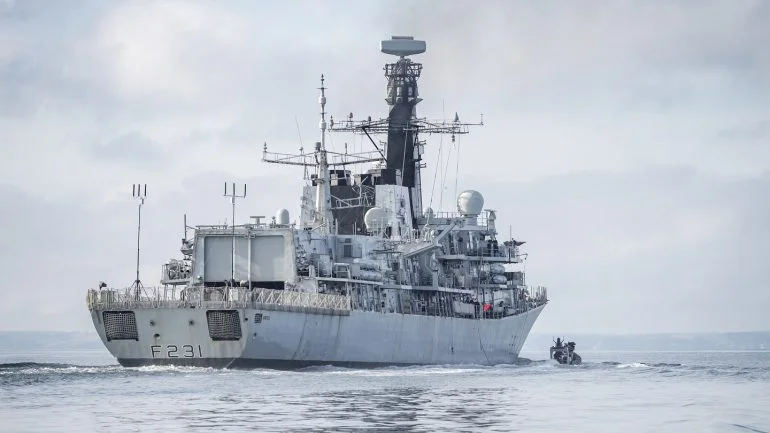The UK Ministry of Defence (MoD) has recently stirred interest within the naval community with its Request for Information (RfI) to replace the legacy Type 82 destroyer HMS Bristol.
This move, driven by the need to restore vital training capabilities for Royal Navy cadets and youth groups, marks a significant step in the evolution of naval training infrastructure.
We’ll dive deep into the implications of this RfI, explore potential candidates for the new Harbour Training Ship (HTS), and analyze the broader context of naval training modernization.
The Legacy of HMS Bristol: A Brief Overview
HMS Bristol, the only Type 82 destroyer ever completed, holds a unique place in Royal Navy history.
Commissioned in 1973, she served actively until 1991, including a notable role during the Falklands War.
Following her decommissioning, HMS Bristol was repurposed as a Harbour Training Ship at HMNB Portsmouth, where she provided essential training and residential accommodation for cadets and youth groups.
Her spacious layout, with room for over 200 personnel, made her an ideal platform for immersive training experiences.
However, by 2020, maintaining HMS Bristol became increasingly difficult due to her age and condition.
The decision to withdraw her from service left a void in the Royal Navy’s training capabilities, which has yet to be filled.
The MoD’s recent RfI aims to address this gap, seeking a new HTS can provide a “Warship Experience” comparable to what HMS Bristol once offered.

Type 23 frigate HMS Argyll may be sold to BAE Systems for apprentice training but could also serve as a Royal Navy harbour training vessel.Image Credit: UK MoD/Crown copyright
The Importance of a Harbour Training Ship in Modern Naval Training
The role of a Harbour Training Ship extends beyond just providing accommodation; it’s about delivering a realistic and immersive experience prepares cadets for life at sea.
An HTS serves as a critical resource for instilling naval discipline, fostering teamwork, and imparting technical skills in a controlled environment.
The absence of such a facility has been keenly felt, as highlighted in the MoD’s RfI, which notes the “significant” reduction in the quality of training experiences since HMS Bristol’s departure.
Historically, an HTS like HMS Bristol could accommodate up to 30,000 bed nights and facilitate around 500 courses annually.
This level of activity underscores the ship’s role as a cornerstone of the Royal Navy’s training regimen.
The new HTS will need to meet or exceed these capabilities, offering a mix of traditional training methods and modern technological enhancements.
Project Powerful: The Search for a New HTS
The MoD’s RfI falls under the umbrella of “Project Powerful,” an initiative aimed at revamping the Royal Navy’s training infrastructure.
According to the RfI, Navy Command is exploring various options for the new HTS, focusing on vessels can provide residential capabilities and a realistic “Warship Experience” in close proximity to water-borne activities.
The timeline for this project is ambitious, with a target date of April 2027 for the new HTS to be operational.
Key Requirements for the New HTS
The RfI outlines several key requirements for the new HTS:
- Residential Capacity: The new HTS should offer gender-neutral accommodation with the capacity to house 200-300 personnel per night. This requirement is crucial for supporting the large number of cadets and youth groups participate in residential training programs.
- Interactive Training Environment: The MoD is looking for a ship can provide an interactive training environment, incorporating physical challenges, scenario simulators, virtual reality activities, and traditional instructional sessions. This blend of old and new training methods is designed to enhance the realism and effectiveness of the training experience.
- Compatibility with Existing Infrastructure: The new HTS must be able to interoperate with existing shore-based facilities, including utilities, berthing infrastructure, and catering services. This requirement suggests the new ship will be integrated into the broader naval training ecosystem, ensuring a seamless transition for trainees.
- Proximity to Water-Based Activities: The HTS should be located near water-based training facilities, enabling cadets to engage in a variety of maritime exercises. This proximity is essential for providing a comprehensive training experience covers both shipboard and water-borne activities.
Potential Candidates for the New HTS
Several decommissioned Royal Navy vessels have been identified as potential candidates for conversion into the new HTS. Let’s take a closer look at the leading contenders.
HMS Echo: A Strong Contender
HMS Echo, a former hydrographic survey vessel, is currently berthed at a non-tidal location awaiting disposal.
With a beam of 16.8 meters and a length of 90.6 meters, HMS Echo offers a size comparable to HMS Bristol, although she is shorter in length.
Her relatively young age and good condition make her a strong contender for conversion into an HTS.
One of the key advantages of HMS Echo is her adaptability.
As a survey vessel, she was designed for extended missions and has ample space for accommodation and training facilities.
Additionally, her modern design could make it easier to incorporate the technological enhancements required for the new HTS, such as virtual reality simulators and interactive training modules.
HMS Ramsey: A Less Likely Option
Another vessel under consideration is HMS Ramsey, a former Sandown-class mine countermeasure vessel (MCMV).
However, there are significant challenges associated with using HMS Ramsey as an HTS.
The RfI notes her glass-reinforced plastic hull may not be suitable for the rigors of conversion, and her current STOROB (store robbery) status—where parts are stripped to sustain other vessels—raises concerns about her viability.
Moreover, HMS Ramsey’s smaller size and limited accommodation capacity make her a less attractive option compared to other candidates.
While she may offer some potential, the challenges associated with her conversion could outweigh the benefits.
Type 23 Frigates: HMS Argyll and HMS Westminster
The MoD is also considering the use of recently decommissioned Type 23 frigates, specifically HMS Argyll and HMS Westminster.
frigates offer a more comparable size to HMS Bristol, with lengths of 133 meters and beams of 16.1 meters.
vessels were active until recently, which could make them suitable candidates for conversion.
HMS Argyll, despite being the oldest serving Type 23 frigate, was undergoing a life-extension program until her decommissioning in 2022.
This program could make her a viable option for the new HTS, as she likely remains in relatively good condition.
HMS Westminster, on the other hand, has been earmarked for scrapping, but her disposal method has not yet been finalized.
The conversion of a Type 23 frigate into an HTS would provide the Royal Navy with a modern, versatile platform capable of accommodating a large number of trainees.
However, the costs associated with converting and maintaining a frigate could be higher than other options, which the MoD will need to consider.
Challenges and Considerations
While the search for a new HTS is underway, there are several challenges and considerations the MoD must address.
Budget Constraints
One of the primary challenges is budget constraints. Converting a decommissioned warship into an HTS is a costly endeavor, involving significant modifications to ensure the vessel meets modern training requirements.
The MoD will need to carefully weigh the costs of conversion against the benefits of each candidate vessel.
Timeline Ambitions
The MoD’s target date of April 2027 for the new HTS to be operational is ambitious.
The process of selecting a vessel, completing the necessary conversions, and integrating the ship into the naval training infrastructure will require careful planning and execution.
Any delays in the process could push the project timeline beyond the intended date.
Technological Integration
The integration of modern training technologies, such as virtual reality simulators and interactive training modules, presents another challenge.
These technologies are essential for providing a realistic and immersive training experience, but they also require significant investment and expertise to implement effectively.
Environmental Considerations
The environmental impact of converting and operating a decommissioned warship as an HTS must also be considered.
The MoD will need to ensure the selected vessel complies with environmental regulations and any modifications are made with sustainability in mind.
The Broader Context: Modernizing Naval Training
The search for a new HTS is part of a broader effort by the Royal Navy to modernize its training infrastructure.
As the nature of naval warfare evolves, so too must the training methods used to prepare the next generation of sailors.
The integration of advanced technologies, such as artificial intelligence and autonomous systems, into naval operations requires a corresponding evolution in training practices.
The Role of Technology in Training
Technology is playing an increasingly important role in naval training.
Virtual reality (VR) and augmented reality (AR) systems, for example, allow trainees to experience realistic combat scenarios in a controlled environment.
These technologies provide a level of immersion and realism traditional training methods cannot match, enabling trainees to develop their skills in a safe and effective manner.
The new HTS will likely incorporate these technologies, providing cadets with a cutting-edge training experience.
The use of VR and AR can simulate a wide range of scenarios, from shipboard firefighting to complex tactical maneuvers, offering a comprehensive training platform prepares cadets for real-world challenges.
The Importance of Realism in Training
While technology plays a crucial role in modern training, the importance of realism cannot be overstated.
The ability to train on a real warship, with all the associated sounds, smells, and physical sensations, provides an experience virtual simulations cannot fully replicate.
This realism is essential for developing the skills and instincts needed to operate effectively in a combat environment.
The new HTS will need to strike a balance between technological innovation and traditional training methods, ensuring cadets receive a well-rounded education prepares them for the realities of naval service.
Conclusion: The Path Forward
The MoD’s search for a new Harbour Training Ship represents a critical step in the modernization of the Royal Navy’s training infrastructure.
The replacement for HMS Bristol will need to provide a comprehensive training experience combines the best of traditional and modern methods, ensuring the next generation of Royal Navy personnel is prepared for the challenges of the future.
As the MoD considers its options, the selection of the right vessel will be key to the success of this initiative.
Whether it’s HMS Echo, a Type 23 frigate, or another candidate, the new HTS will play a vital role in shaping the future of Royal Navy training.
The ambitious timeline, budget constraints, and technological integration challenges will require careful management.
However the potential rewards—enhanced training capabilities, improved readiness, and a more capable Royal Navy—are well worth the effort.


































